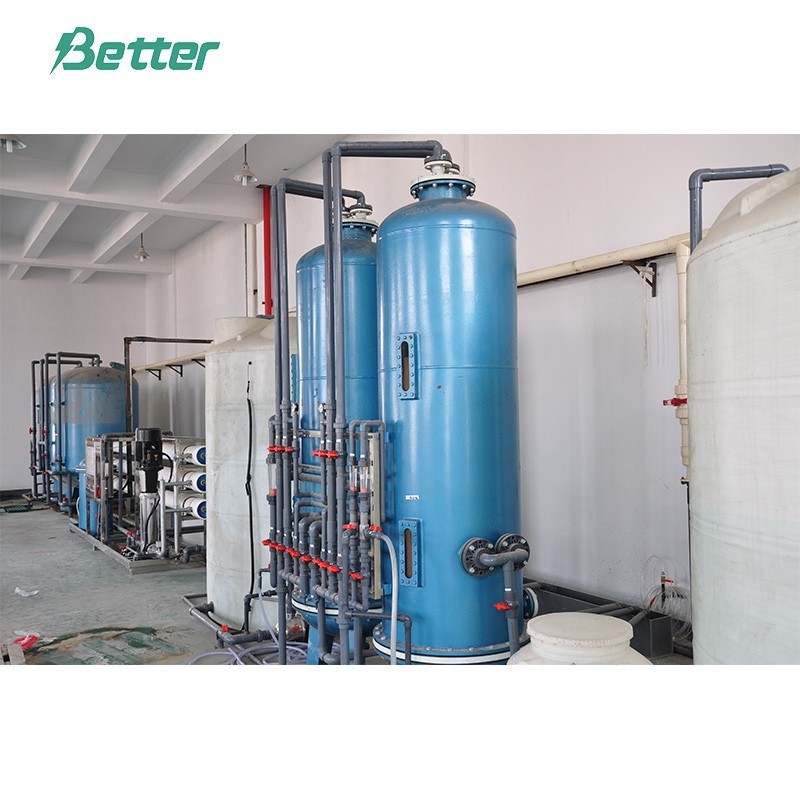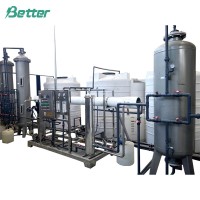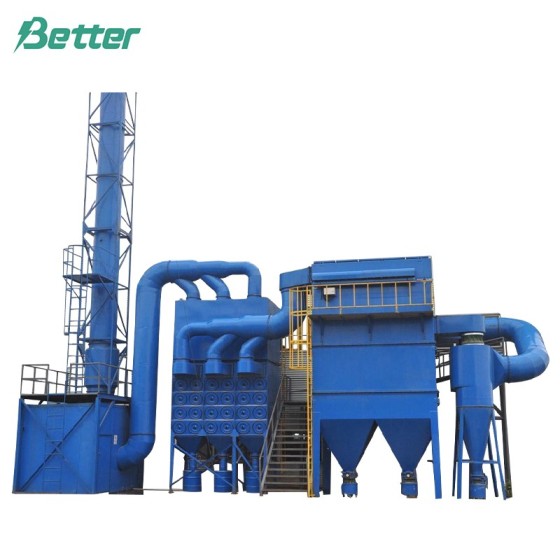
- Home
- >
- Products
- >
- DM Water Plant
- >
DM Water Plant
DM Water plant applies to manufacturing the DM water for lead acid battery manufacturing process.
DM water used in the Paste mixing process, Acid dilution process, etc.
- BETTER
- CHINA
- Information
DM Water Plant
Design Consideration
1. Raw water source:Tap water
2. Water production purpose:Process water
3. Process water:pretreatment + Level 1 reverse outlet + Ion Exchange:DM water
4. Effluent quality:electrical resistivity≥8MΩ.cm(ion exchanger mixed-bed outlet)
5. Water utilization rate:≥70%
6. Design range:From the inlet of active carbon filter to the outlet of pure water tank
7. Electrical control range:From the main electrical cabinet to the electricity control point circuit
Technological Process
![]()
![]()
![]()
![]() Flocculation dosing Scale inhibitor dosing
Flocculation dosing Scale inhibitor dosing
Raw water tank→ raw water pump→ mechanical filter→ active carbon filter→ ultrafilter→
![]()
![]()
![]()
![]() Chemical cleaning Conductivity online monitoring
Chemical cleaning Conductivity online monitoring
![]() booster pump→ reverse osmosis device→ fresh-water tank→ fresh-water pump→ Mixed ion exchange column (acid and alkali regenerative unit) → DM water tank→ DM water pump →water consuming point Conductivity online monitoring
booster pump→ reverse osmosis device→ fresh-water tank→ fresh-water pump→ Mixed ion exchange column (acid and alkali regenerative unit) → DM water tank→ DM water pump →water consuming point Conductivity online monitoring
System Control Type
1. The DM water plant controls the working status of each device automatically.
2. Low pressure protection device should be installed before reverse osmosis device, ensuring that multiple-stage centrifugal pump works in the normal condition of no water shortage.
3. High pressure protection device is equipped behind the pump to avoid the damage of multiple-stage centrifugal pump due to starting the RO device before opening the multiple-stage centrifugal pump, or the damage of the membrane component due to the RO device concentrated water discharge valve is not opened properly so that the membrane component is pressed and raised suddenly.
4. The mechanical filter and activated carbon filter are controlled by manual to finish the front flush and back flush of the filter material.
5. The water inflow is controlled by solenoid valve, the water tank is equipped with high, middle and low liquid level switch. When reaching the high liquid level, the equipment will stop automatically; when reaching middle liquid level, the equipment will start automatically; when reaching low liquid level, the water pump will stop automatically to protect the pump.
6. For the water outlet quality, both the RO and mixed ion exchange column are equipped with digital conductivity meter for online monitoring.
7. Electricity control is with PLC control, realizing unmanned management during normal water treatment, the screen indicates data of the electric conductivity, operating pressure, water outlet, etc.
Technical Description
1. Mechanical filter
There is dust with very fine particles, microorganism like bacterium and algae humus and ion like iron in the raw water. Mixed with water, these miscellaneous substances will be formed into colloidal particles, which can be removed after treatment with mechanical filter and carbon filter, ensuring that the feed water meets the requirement of electrodialysis water F1 index, i.e. less than 4. We use quartz sand as filter material in the mechanical filter to remove the flocculation impurities (mainly organic matter, humus, clay and particle type inorganic compounds) and ion like iron, making the turbidity of the outlet water is less than 0.5NTU.
2. Active carbon filter
The SPI of the inlet water for the RO should not be more than 4, another index is residual chlorine less than 0.1mg/L. The main functions of active carbon filter: ① absorbing the organic matter in the water, the adsorption rate is about 60%; ② absorbing the residual chlorine in the water (For the 10-20 angstrom inorganic colloid, organic colloid, soluble organic macromolecular impurities and residual chlorine, they are difficult to be removed in the process of the mechanical filter). In order to further purify the raw water and make it satisfy the index of RO inlet water, it’s very important to install the active carbon filter. There is micropore and particle gap with 20-50 angstrom pore diameter in the active carbon particles, this structure makes the surface adsorption area of the active carbon particles reach 500-2000m2/g. As the molecular diameter of the general organic matter is less than 20-50 angstrom, so the active carbon is the most effective for the absorption of organic matter. Moreover, as the active carbon surface contains oxygenic function groups like hydroxide radical, so the active carbon is very effective for adsorption of oxidant in the water. The active carbon can also remove the stink, chromaticity and turbidity, increasing the cleanliness of the water. The tank of the active carbon filter is made of stainless steel.
3. Cartridge filter
As the last treatment process for raw water entering into the RO, the cartridge filter prevents the reverse osmosis membrane from scratching or blocking by the remaining submicroscopic particles in the front filter process. The filter is with 5μ melt-blown PP filter cartridge.
4. High-pressure pump
The outlet water from the cartridge filter will enter into the RO desalination system. The pump body and base is made of stainless steel, the high-pressure pump adopts pressure water supply with high pressure and low pressure protection, in case of damage of the pump. The pump is with stable performance, ensuring the reliable operation of the system.
5. Main part of the reverse osmosis desalting device
Main part of the RO is the chemical cleaning system. The RO component adopts the U.S.A. HYDECANME spiral-wound membrane components. The RO produces water 0.5m3/h (design water temperature is 25℃) , equipped with CAP-3-8040 membrane. The water recovery rate is 70%, desalinization rate over 98%. There is electromagnetic quick-opening valve at the outlet of the high-pressure pump, realizing mass flushing for RO membrane when start and shutdown. When the pressure of high-pressure pump outlet exceeds certain value and delays for a period of time, the membrane can be low-pressure cleaned with water from pretreatment system, in case of scale formation caused by concentrated water remaining on the surface of the membrane.
6. Washing equipment
The washing system includes the washing tank and washing pump. After being used under the pressure for a period of time, the RO membrane will be blocked by scale formation of concentrated water, which will affect the water productivity and desalinization rate, in this case, RO chemical cleaning should be done to recover the desalinization performance. Cleaning period of the RO cleaning is related to the pretreatment system, raw water quality, pretreatment equipment operation and control of pretreatment outlet water quality, generally the cleaning period of RO membrane is about 3-4 months.
7. Flesh water tank
The RO outlet water will be stored in the fresh tank and then enter into the next process. The volume is 1m3 , material is PE.
8. Flesh water pump
Intermediate water pump, the pump is with overheat protector to increase the reliability of service of the pump.
9. Ion exchange unit
The negative ion and positive ion exchange unit is one of the most common equipments in the desalination and water purification system. The equipment realizes desalination in the principle of negative ion and positive ion exchange.
According to the requirement of different process, it can fill with enhanced resin, weak type positive ion resin and negative ion resin. The various desalting system is formed by different unit combination, to meet the demand of process water in different industry. This process adopts mixed ion exchange column replacement, aiming at increase the desalinization rate.
Ion exchange refers to the equal charge reaction between the water ion and resin ion.
The reaction process of ion exchange can be described as following: HR+Na+=Na++H+
From the above formula, we know that: During the ion exchange reaction, the positive ion (like Na+) in the water is transferred onto the resin, while one –H on the resin is transferred into the water. The process that Na+ is transferred from the water to the resin is the replacement process, while the process that H on the resin is transferred to the water is the free process. The Na+ and -H are replaced each other due to the replacement and free process, this transformation is called ion exchange.
10. DM water tank
The water becomes DM water after treatment by RO equipment and mixed resin bed system, and enters into the DM water tank. The quality requirement differs from different process demand. This DM water tank is with volume of 1m3 , material is PE.
11. Delivery pump
One piece of intermediate water pump is stainless steel , with overheat protector, increasing the reliability of service.












